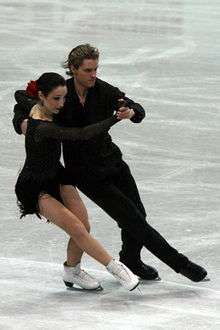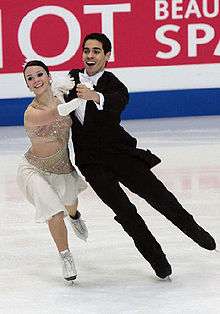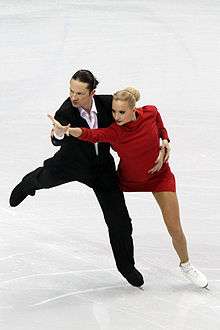Compulsory dance
Compulsory dances, now called pattern dance in ice dancing, are a part of ice dancing and artistic roller skating in which all the couples perform the same standardized steps and holds to music of a specified tempo. One or more compulsory dances were usually skated as the first phase of ice dancing competitions. The 2009-10 season was the final season in which the segment was competed in ISU junior and senior level competition.[1] In June 2010, the International Skating Union replaced the name "compulsory dance" with "pattern dance" for ice dancing,[2] and merged it into the short dance beginning in the 2010–2011 figure skating season.
Compulsory dances are also popular as a form of recreational or social dance among skaters.
The patterns for most dances either cover one-half or one full circuit of the rink. The International Skating Union (ISU) and the Fédération Internationale de Roller Sports (FIRS) publish the step diagrams and descriptions of the dances that are competed internationally, and also provides a set of standard music recordings for each dance with uniform tempo and introductory phrasing for use in competition.
Ice dancing





.jpg)
The dances that have been performed in junior and senior international competition include:
| Name | First performed | Creators | Other notes |
|---|---|---|---|
| Fourteenstep[3] | 1889 | Franz Scholler | Also known as Ten Step or Scholler March. |
| European Waltz[4] | before 1900 | unknown | |
| American Waltz[5] | unknown | unknown | |
| Kilian | 1909 | Karl Schreiter | |
| Tango[6] | 1932 | Paul Krechkow, Trudy Harris | |
| Foxtrot[7] | 1933 | Eric van der Weyden, Eva Keats | |
| Argentine Tango[8] | 1934[9] | Reginald J. Wilkie, Daphne B. Wallis | |
| Blues[10] | 1934 | Robert Dench, Lesley Turner | |
| Rocker Foxtrot[11] | 1934 | Eric van der Weyden, Eva Keats | |
| Viennese Waltz[12] | 1934[13] | Eric van der Weyden, Eva Keats | |
| Paso Doble | 1938 | Reginald B. Wilkie, Daphne B. Wallis | |
| Quickstep | 1938 | Reginald J. Wilkie, Daphne B. Wallis | |
| Rhumba | 1938 | Walter Gregory | |
| Westminster Waltz | 1938 | Eric van der Weyden, Eva Keats | |
| Silver Samba | 1963 | Courtney J. L. Jones, Peri V. Horne | |
| Starlight Waltz[14] | 1963 | Courtney J. L. Jones, Peri V. Horne | |
| Yankee Polka[15] | 1969 | James Sladky, Judy Schwomeyer, Ronald Ludington | |
| Ravensburger Waltz | 1973 | Angelika Buck, Erich Buck, Betty Callaway | |
| Tango Romantica | 1974 | Lyudmila Pakhomova / Aleksandr Gorshkov, Elena Tchaikovskaia | |
| Austrian Waltz | 1979 | Susi Handschmann, Peter Handschmann | |
| Golden Waltz[16] | 1987[17] | Natalia Dubova, Marina Klimova / Sergei Ponomarenko | |
| Cha Cha Congelado | 1989 | Bernard Ford, Kelly Johnson, Laurie Palmer, Steven Belanger | |
| Finnstep[18] | 1995[19] | Susanna Rahkamo / Petri Kokko, Martin Skotnicky. | Kati Winkler / René Lohse helped adapt to CD. |
| Midnight Blues | 2001 | Roy Bradshaw, Sue Bradshaw, Mark Bradshaw, Julie MacDonald |
The American Waltz, European Waltz, Fourteenstep, and Kilian (a march) date back to the early days of figure skating. Several of the compulsory dances were first performed by dancers in the United Kingdom in the 1930s. Others were adapted from original dances performed after that segment was added to dance competitions in the 1960s. For example, the Golden Waltz, considered the most complex and challenging of the compulsory dances, was adapted from the original set pattern performed by Marina Klimova and Sergei Ponomarenko in the 1987 season.
In addition to the international dances, there are also several simpler dances that are taught to beginning skaters. For example, in the United States, the first dance learned by most skaters is the Dutch Waltz, which features only forward skating in a side-by-side hold, skated to music with a very slow waltz tempo.
By season
Each season, the ISU published a number of compulsory dances to be competed that season on both the international senior level and junior level. Which compulsory dance was competed depended on the event, and some events, such as the Grand Prix of Figure Skating Final, had no compulsory dance segment in the competition.
Although the ISU published assigned dances for the 2010-11 season, these were not used in competition, as the compulsory and original dances were merged into a single segment, the short dance, starting in 2010-11. The International Skating Union adopted the name "pattern dance" in 2010 and in 2011 U.S. Figure Skating also switched to the new name.[20]
| Season | Senior-level[21] | Junior-level[21] |
|---|---|---|
| 2005–2006 | Yankee Polka Ravensburger Waltz Tango Romantica |
Paso Doble Austrian Waltz Westminster Waltz Quickstep |
| 2006–2007 | Westminster Waltz Golden Waltz Rhumba |
Starlight Waltz Silver Samba Midnight Blues |
| 2007–2008 | Austrian Waltz Yankee Polka Argentine Tango |
Viennese Waltz Cha Cha Congelado Blues |
| 2008–2009 | Viennese Waltz Finnstep Paso Doble |
Starlight Waltz Paso Doble |
| 2009–2010 | Golden Waltz Tango Romantica |
Westminster Waltz Argentine Tango[22] |
| 2010–2011 | Ravensburger Waltz Finnstep |
Quickstep Blues [23] |
Artistic roller skating
The dances that are performed in junior and senior international competition include[24]
- Argentine Tango
- Blues
- Castel March
- Flirtation Waltz
- Fourteen Step
- Fourteen Step Plus
- Harris Tango
- Iceland Tango
- Italian Foxtrot
- Kilian
- Paso Doble
- Quickstep
- Rocker Foxtrot
- Starlight Waltz
- Tango Delanco
- Westminster Waltz
Artistic roller skating in the United States also has competitive divisions of team and solo dance for all ages and skill levels that compete at the local, regional, and national levels. At competitions, skaters perform between two and six dances set to organ music for a maximum of 3 minutes per dance. Skaters are judged on a number of things that include American technique, pattern placement, and overall performance.
By season
| Season | Senior | Junior | Senior Solo | Junior Solo |
|---|---|---|---|---|
| 2005-2006 | Starlight Waltz Iceland Tango |
Blues Harris Tango |
||
| 2006-2007 | Paso Doble Westminster Waltz |
Rocker Foxtrot Flirtation Waltz |
Blues Harris Tango | |
| 2007-2008 | Kilian Quickstep |
Fourteen Step Imperial Tango |
- - |
Rocker Foxtrot Flirtation Waltz |
| 2008-2009 | Italian Foxtrot Argentine Tango |
Blues Harris Tango |
Quickstep Westminster Waltz |
14 Step Plus Imperial Tango |
| 2009-2010 | Castel March Starlight Waltz |
Rocker Foxtrot Flirtation Waltz |
Paso Doble Argentine Tango |
Harris Tango Blues |
| 2010-2011 | Paso Doble Westminster Waltz |
Fourteen Step Imperial Tango |
Italian Foxtrot Iceland Tango |
Flirtation Waltz Rocker Foxtrot |
References
- ↑ "ISU Congress News". ice-dance.com.
- ↑ "Communication No. 1621". International Skating Union. June 24, 2010. Retrieved July 19, 2011.
- ↑ "1. Fourteenstep" (PDF). International Skating Union. Archived (PDF) from the original on 12 November 2012.
- ↑ "4. European Waltz" (PDF). International Skating Union. Archived (PDF) from the original on 12 November 2012.
- ↑ "5. American Waltz" (PDF). International Skating Union. Archived (PDF) from the original on 12 November 2012.
- ↑ "21. Tango" (PDF). International Skating Union. Archived (PDF) from the original on 12 November 2012.
- ↑ "2. Foxtrot" (PDF). International Skating Union. Archived (PDF) from the original on 12 November 2012.
- ↑ "22. Argentine Tango" (PDF). ice-dance.com.
- ↑ "Argentine Tango". ice-dance.com.
- ↑ "24. Blues" (PDF). International Skating Union. Archived (PDF) from the original on 12 November 2012.
- ↑ "3. Rocker Foxtrot" (PDF). International Skating Union. Archived (PDF) from the original on 12 November 2012.
- ↑ "7. Viennese Waltz" (PDF). ice-dance.com.
- ↑ "Viennese Waltz". ice-dance.com.
- ↑ "9. Starlight Waltz" (PDF). International Skating Union. Archived (PDF) from the original on 12 November 2012.
- ↑ "13. Yankee Polka" (PDF). International Skating Union. Archived (PDF) from the original on 12 November 2012.
- ↑ "11. Golden Waltz" (PDF). ice-dance.com.
- ↑ "Golden Waltz". ice-dance.com.
- ↑ "15. Finnstep" (PDF). ice-dance.com.
- ↑ "Finnstep". ice-dance.com. Archived from the original on 2012-10-28.
- ↑ p.32, 2011-12 Tests Book", U.S. Figure Skating http://www.usfsa.org/Content/201112TestsBook.pdf (accessed July 19, 2011).
- 1 2 "Compulsory & Original Dance History". ice-dance.com.
- ↑ "International Skating Union Communication No. 1496" (PDF). International Skating Union. 2 May 2008. Retrieved 8 February 2010.
- ↑ "ISU Communication No. 1567 ICE DANCE" (PDF). International Skating Union. 8 May 2009. Retrieved 8 February 2010.
- ↑ "Artistic Roller Skating Special Regulations & Sports Rules : 2009 Edition" (PDF). Federation International de Roller Skating. Retrieved 8 February 2010.
External links
| Wikimedia Commons has media related to Compulsory dances. |
- Technical reference at ice-dance.com
- International Skating Union
- ISU Judging System: Ice Dance at the International Skating Union
- Ice dancing at U.S. Figure Skating